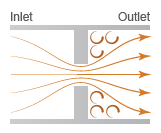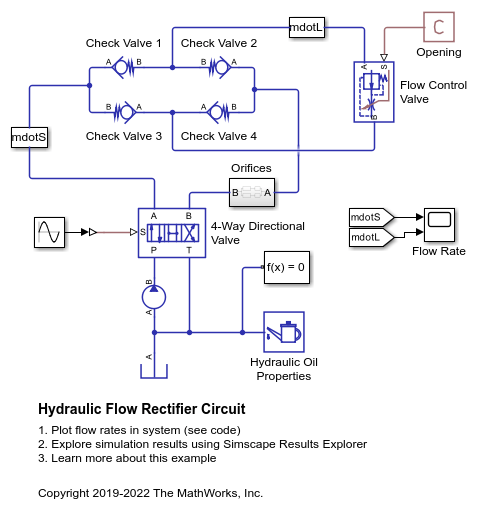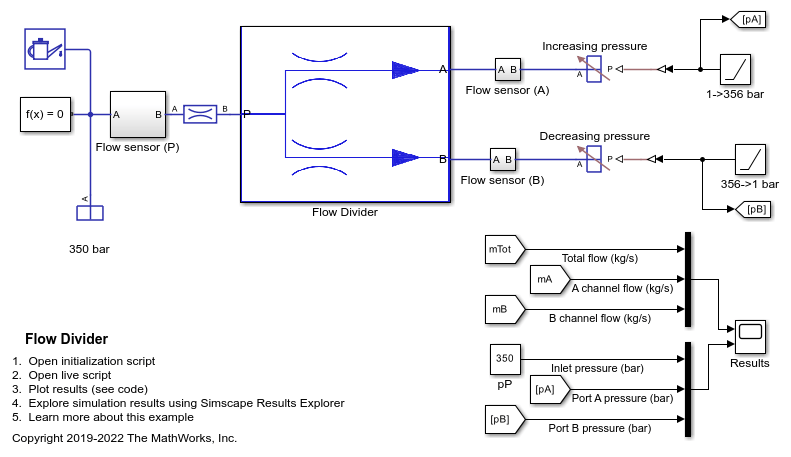Orifice (IL)
Constant-area or variable-area orifice in an isothermal liquid system
Libraries:
Simscape /
Fluids /
Isothermal Liquid /
Valves & Orifices /
Orifices
Description
The Orifice (IL) block models the flow through a local restriction with a constant or variable opening area. For variable orifices, a control member connected to port S sets the opening position. The opening area is parametrized either linearly or by lookup table.
For orifices that open and close based on the displacement of a central spool, see Spool Orifice (IL).

The block conserves mass such that
This mass balance implies that there is an increase in velocity when there is a decrease in area, and a reduction in velocity when the flow discharges into a larger area. In accordance with the Bernoulli principle, this change in velocity results in a region of lower pressure in the orifice and a higher pressure in the expansion zone. The resulting increase in pressure, which is called pressure recovery, depends on the discharge coefficient of the orifice and the ratio of the orifice and port areas.
Constant Orifices
For constant orifices, the orifice area, Aorifice, does not change over the course of the simulation.
Constant Area ParameterizationThe block calculates the mass flow rate as
where:
Cd is the Discharge coefficient.
Aorifice is the instantaneous orifice open area.
Aport is the Cross-sectional area at ports A and B.
is the average fluid density.
PRloss and Δpcrit are calculated in the same manner for constant and variable orifices and are defined in the Pressure Loss and Critical Pressure sections below.
This approximation for and the Local Restriction (IL) block are the same.
Tabulated data - Volumetric flow rate vs. pressure
drop ParameterizationThe volumetric flow rate is determined from the tabulated values of the pressure differential, Δp, which you can provide. If you provide only non-negative values for both the volumetric flow rate and pressure drop vectors, the block extrapolates the table to contain negative values. The volumetric flow rate is interpolated from this extended table.
If the Volumetric flow rate vector and Pressure drop vector parameters contain both negative and positive values but no 0, the block inserts an origin into the vectors to ensure the valve does not have nonzero flow rate when the pressure drop is 0, which is non-physical.
Variable Orifices
For variable orifices, setting Opening orientation to
Positive control member displacement opens orifice
opens the orifice when the signal at S is positive, while a
Negative control member displacement opens orifice
orientation opens the orifice when the signal at S is negative.
In both cases, the signal is positive and the orifice opening is set by the
magnitude of the signal.
Linear - Area vs. control member position
ParameterizationThe orifice area Aorifice is based on the control member position and the ratio of orifice area and maximum control member position:
where:
Smin is the control member position when the orifice is fully closed.
ΔS is the Control member travel between closed and open orifice.
Amax is the Maximum orifice area.
Aleak is the Leakage area.
ε is the Opening orientation.
When the valve is in a near-open or near-closed position in the linear parameterization, you can maintain numerical robustness in your simulation by adjusting the Smoothing factor parameter. If the Smoothing factor parameter is nonzero, the block smoothly saturates the orifice area between Aleak and Amax. For more information, see Numerical Smoothing.
The volumetric flow rate is determined by the pressure-flow rate equation:
where A is the Cross-sectional area at ports A and B.
Tabulated data - Area vs. control member position
ParameterizationWhen you use the Tabulated data - Area vs. control member
position parameterization, the orifice area
Aorifice is interpolated from the
tabulated values of opening area and the control member position,
ΔS, which you can provide. As with the
Linear - Area vs. control member position
parameterization, the volumetric flow rate is determined by the pressure-flow
rate equation:
where Aorifice is:
Amax, the last element of the Orifice area vector, if the opening is larger than the maximum specified opening.
Aleak, the first element of the Orifice area vector, if the orifice opening is less than the minimum opening.
Aorifice if the calculated area is between the limits of the Orifice area vector.
Aopen is a function of the control member position received at port S. The block queries between data points with linear interpolation and uses nearest extrapolation for points beyond the table boundaries.
Tabulated data - Volumetric flow rate vs. control
member position and pressure drop ParameterizationThe Tabulated data - Volumetric flow rate vs. control member
position and pressure drop parameterization interpolates the
volumetric flow rate directly from a user-provided volumetric flow rate table,
which is based on the control member position and pressure drop over the
orifice. The block queries between data points with linear interpolation and
uses linear extrapolation for points beyond the table boundaries.
This data can include negative pressure drops and negative opening values. If a negative pressure drop is included in the dataset, the volumetric flow rate will change direction. However, the flow rate will remain unchanged for negative opening values.
If the Pressure drop vector, dp parameter does not contain a 0 and the Volumetric flow rate table, q(s,dp) parameter does not contain a corresponding column of 0's, the block inserts them to ensure the valve does not have nonzero flow rate when the pressure drop is 0, which is non-physical.
Pressure Loss
Pressure loss describes the reduction of pressure in the valve due to a decrease in area. The pressure loss term, PRloss is calculated as:
Pressure recovery describes the positive pressure change in the valve due to an increase in area. If you do not want to capture this increase in pressure, clear the Pressure recovery check box. In this case, PRloss is 1.
Critical Pressure
The critical pressure difference, Δpcrit, is the pressure differential associated with the Critical Reynolds number, Recrit, which is the point of transition between laminar and turbulent flow in the fluid:
Faults
When the Orifice type parameter is
Variable, the block can model faults.
To model a fault, in the Faults section, click the Add fault hyperlink next to the fault that you want to model. Use the fault parameters to specify the fault properties. For more information about fault modeling, see Introduction to Simscape Faults.
The Opening area when faulted parameter has three fault options:
Closed— The orifice freezes at its smallest value, depending on the Orifice parameterization:When Orifice parameterization is set to
Linear - Area vs. control member position, the orifice freezes at the Leakage area.When Orifice parameterization is set to
Tabulated data - Area vs. control member position, the orifice freezes at the first element of the Orifice area vector.When Orifice parameterization is set to
Tabulated data - Volumetric flow rate vs. control member position and pressure drop, the orifice freezes at the first row of the Volumetric flow rate table, q(s,dp).
Open— The orifice freezes at its largest value, depending on the Orifice parameterization:When Orifice parameterization is set to
Linear - Area vs. control member position, the orifice freezes at the Maximum orifice area.When Orifice parameterization is set to
Tabulated data - Area vs. control member position, the orifice freezes at the last element of the Orifice area vector.When Orifice parameterization is set to
Tabulated data - Volumetric flow rate vs. control member position and pressure drop, the orifice freezes at the last row of the Volumetric flow rate table, q(s,dp).
Maintain at last value— The orifice seizes at the open area or volumetric flow rate when the trigger occurs.

